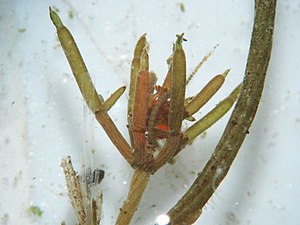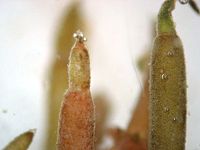Horn-leaved candelabrum
| Horn-leaved candelabrum | ||||||||||||
|---|---|---|---|---|---|---|---|---|---|---|---|---|

Horn-leaved candelabrum ( Chara tomentosa ) |
||||||||||||
| Systematics | ||||||||||||
|
||||||||||||
| Scientific name | ||||||||||||
| Chara tomentosa | ||||||||||||
| L. , 1753 |
The more or less variable, diocese horned candelabrum ( Chara tomentosa ), also called antler candelabrum , is a rare candelabrum from the Characeae family . The alga is persistent. It winters in deep water with its green sprouts. Fruiting plants are extremely rare.
Occurrence
The horn-leaved chandelier alga occurs in mesotrophic clear water lakes up to a depth of 6 m. In shallow water it is rarely found at 0.5 m. Occasionally plants were still observed at a depth of 30 m. It is common in lakes around the Baltic Sea region. So it occurs from Schleswig-Holstein, via Mecklenburg-Western Pomerania to western Russia. There are other stocks in southern Sweden and Denmark. A very small population was discovered in Ireland. Otherwise the algae will come in B. in the Traunsee. Former stocks in Lake Constance were probably destroyed by humans for compost production. In contrast, it is very rare in the southern regions of Europe. Its southernmost occurrence is in Saudi Arabia and its easternmost in Mongolia. The stocks are currently falling sharply. The alga can no longer be found in many lakes that are heavily used by humans. Relatively stable populations are currently only found in pristine, protected lakes.
Identifying features
The horn-leaved chandelier alga is often strongly developed, encrusted with lime and appears rigid and gnarled. It is particularly noticeable that the young shoots are reddish in color. The species is persistent; therefore it is not uncommon for long rungs from previous years to be found under the new shoot. In shallow water, the alga appears squat. In contrast, it grows elongated in deep water. Their rungs are about 0.5 to 2 mm wide in diameter. The internodes are 3 cm to 12 cm long, three to four of them are usually barked. The branches, up to 8 cm long, are 6 or 7 in the whorl. In the male representatives these are curved towards the shoot, in the female plants they are spread out. In this way, the sex of the diocese species can be determined without antheridia and gametangia . The bark is diplostich , more rarely triplostich , but then mostly irregular. The up to 2 mm long spines are located on the protruding rows of bark (are therefore tylacanth ). They can appear individually or are 2 or 3 together. There are also 2 to 3 end cells on each branch that are not barked. The lower end cell is often inflated thickly. The stipulars resemble the spines. Two pairs of them are irregularly distributed under each branch. The up to 2 mm long leaflets are 5 or 6 on the branch and protrude on all sides and are often pointed.
The very large antheridia are reddish in color and up to 1.2 mm in diameter. The female plants develop 1 to 3 gametangia in summer to autumn. They are always on the barked limbs. The oogon is about 1 mm long and 0.75 mm wide. It has 15 to 18 turns and its crown is about 0.2 mm wide and 0.4 mm high. The yellowish brown, only rarely dark brown colored, elongated ellipsoidal shaped oospore is usually 1 mm long and 0.65 mm wide. It has 14 to 16 ribs and, when ripe, has a translucent, thin lime shell.
literature
- Werner Krause, Hanuš Ettl , Georg Gärtner, H. Heynig, D. Mollenhauer: Freshwater flora of Central Europe. Volume 18: Charales (Charophyceae) . - Gustav Fischer Verlag, 1997. ISBN 3-437-25056-6


